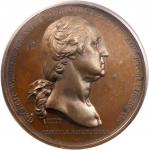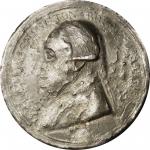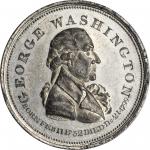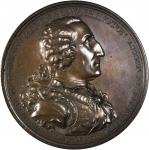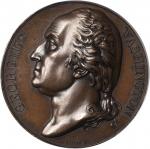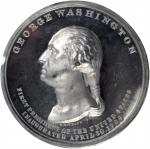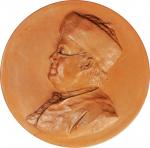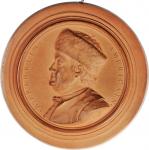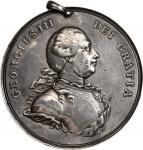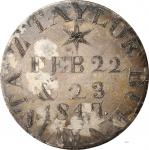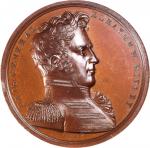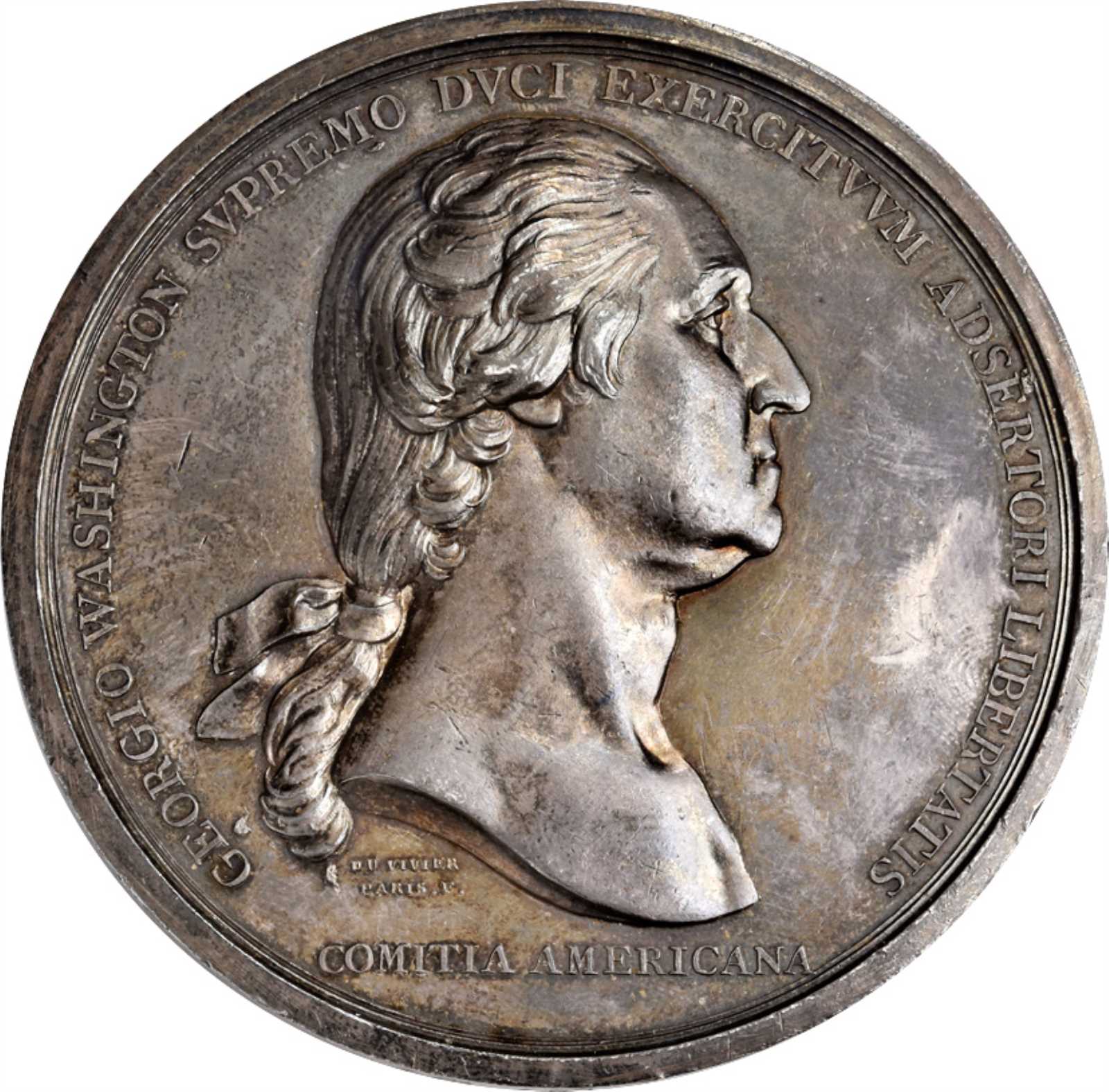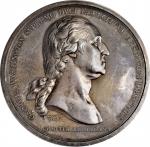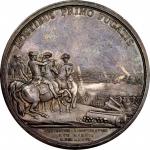1776年波士顿奖牌 PCGS SP 61
1776 (ca. 1789) Washington Before Boston Medal. First Paris Mint Issue. Silver. 68.5 mm. 2761.8 grains. Musante GW-09-P1, Baker-47, Betts-542, Julian MI-1, Adams-Bentley 3. Specimen-61 (PCGS).Lovely pearlescent silver and gray toning dominate the surfaces throughout. The fields are generously reflective, particularly so in the most protected areas close to the devices and through the legends. Both sides are accented by delightful mottled overtones of pale blue, green, gold and rose. Close inspection reveals a bit of handling, including light cabinet friction on the highest points and scattered fine marks. However, the beautiful toning masks much of this and the overall eye appeal upon first inspection is probably on par with the finest of those in private hands. Indeed, the aesthetic quality of this medal is virtually ideal. The plain edge bears two unusual features. At 6 oclock relative to the obverse will be found neatly engraved, ALFRED B. CARB, the name of a former owner that is now inextricably tied to this medal. It is quite likely that this specimen will forever be referred to as the Carb specimen, as no further provenance of this newly discovered example has been traced. At 12 oclock, a small area of file marks is seen, which we presume to be a result of this piece being held firm for the mentioned engraving directly opposite it. Neither feature is visible from the obverse or reverse.In the vast canon of medals that document and celebrate events and persons of American history, the Washington Before Boston is considered by many to be the most important. Though the dies were prepared by the skilled hand of French engraver Pierre Simon Benjamin Duvivier, and the original medals were struck at the Paris Mint out of necessity, it is a uniquely American medal. It was the first authorized and commissioned by the American Congress, it was struck in celebration of a pivotal and remarkable moment in the American Revolution, and it was awarded to not only the first American president, but also arguably the single most revered American in history. It is tied firmly to the foundations of the nation.Perhaps the finest testament to the immense and long-standing desirability of this medal may be found in the large number of variations that have been produced since the first one was struck, the gold specimen presented to George Washington. The few silver originals and a number of bronzes were produced fairly contemporaneously to Washingtons gold example -- a fact easily supported by the similar die states of the known medals. Presumably, these were distributed widely and quickly. It wasnt long before continued demand for the medals was made known, and more examples were struck to fill requests. Early restrikes were produced at the Paris Mint, and later iterations were made both in Paris and at the United States Mint in Philadelphia. These variations are well documented in the literature, but the fact that the demand for the historic design has endured for more than two hundred years is what is most significant in the context of an offering of this silver original.With Washingtons unique gold one in the care of the Boston Public Library, the very rare original impressions in silver represent the very pinnacle of what a collector can acquire. They are as close as one can come to the gold original, the relevant actions and sentiments of the American Congress, and the inherent celebration of George Washington that these medals represent. This discovery of a new specimen of a silver original Washington Before Boston medal is a landmark occasion. This is the first new example available to collectors in decades.The earliest auction appearance we are aware of for a silver example was in W. Elliot Woodwards April 1863 sale. That piece was the property of Henry M. Brooks, one of Americas early collectors, active in the 1850s. It was called "splendid proof." Another appeared in the June 1873 sale of selections from the Parmelee and Seavey collections, by William Strobridge, simply called a "fine proof." One was offered by Edouard Frossard in his February 1884 sale of the Isaac Wood Collection, called "Silver, very fine." Another similar listing of one may be found in the February 1892 sale by Sotheby, Wilkinson & Hodge, called "very fine and rare." Though it was known to American numismatists in this time period that the Washington Before Boston medals existed as both originals and later reissues (this distinction having been made for bronze offerings as far back as 1859), such was not specified in any of these old appearances of silver examples, perhaps attributable to sins of omission. We may never know if these early appearances were of original impressions, but it seems more likely than not that they were early reissues. Far more significant is the list of important collections and sales that did not include this great rarity in silver. Among these may be counted the holdings of John McCoy (1864), Joseph Mickley (1867), Ira Bushnell (1882), Sylvester Crosby (1883), Isaac Wood (1894), William Spohn Baker (d.1897), Matthew Stickney (1907), Henry Jewett (1909), Andrew Zabriskie (1909), George Parsons (1914), W.W.C. Wilson (1925), F.C.C. Boyd (1950s), the Garrett family (1979-1981), Gilbert Steinberg (1996) and the Norwebs (2006). It is remarkable indeed that none of these collections contained an original example of this medal in silver, though all of these collections included extensive holdings of important Washington medals and the collectors certainly had the financial means to acquire such a medal had one been made available to them.As noted in our March 2014 description of the Charles Wharton Collection specimen, the last example of a silver original to be sold, it was Thomas Jeffersons wish that these medals would be included in the collections of "major centers of learning" and it may be that, beyond the cased set of silver Comitia Americana medals presented to Washington himself, most or all of the other original silver impressions of this medal were presented to institutions. This, in concert with the rarity of the medals, might explain why it seems to have been well more than a century before examples began to occasionally show up in private collections. Indeed, of the 11 known specimens, two are in collections of European museums, institutions which may have been original recipients, and four additional pieces are now in institutional collections in the United States, all aligning with Jeffersons desires. The 11 known medals are as follows, derived partly from the Adams and Bentley list published in their 2007 book, Comitia Americana and Related Medals:1 - George Washingtons Personal Example. Presented to him in a cased set of Comitia Americana medals. Now in the collections of the Massachusetts Historical Society.2 - Museum of Fine Arts, Boston.3 - Metropolitan Museum of Art, New York.4 - Kunsthistoriches Museum, Vienna.5 - State Hermitage Museum, St. Petersburg.6- Colonial Williamsburg Foundation. Sold to John J.Ford, Jr. by Jean Vinchon of Paris, May 1967. Acquired by Joseph Lasser in our (Stacks) Ford Sale, and gifted to Colonial Williamsburg.7 - The Charles Wharton Collection Specimen. Sold by Fred Baldwin of London in the late 1950s to Dr. Paul Patterson. Later in the collections of Alan V. Weinberg, David Dreyfuss, and Admiral J. William Middendorf.8 - The Lucien LaRiviere Specimen. Said to have been revealed in a medal collection in Lima, Peru, in 1961. Acquired by Dr. George Fuld and later owned by Richard Picker, and John J. Ford, Jr.9 - A Private New England Collection. Sold by Rossa and Tanenbaum. No prior history known.10 - "Private Collection." One of four so described by Adams and Bentley.11- Alfred B. Carb Specimen, the present example. Unrecorded prior history and believed to be described here for the first time.In our firms history, we have now handled at auction four of the reported examples, the first of which appeared in our (Bowers and Merenas) 1986 sale of the David W. Dreyfuss Collection, and brought $18,150. In 1999, we (Bowers and Merena) sold the Lucien LaRiviere specimen which realized $64,400. In 2004, the John J. Ford specimen appeared in Part II of our (Stacks) series of sales featuring his vast holdings. That piece brought $43,125, and in 2014 the Charles Wharton Collection example surpassed all expectations when it sold for $282,000. By a certain measure, this one might be deemed the most remarkable among them as it has been more than a half century since an undocumented example has come to light and been made available to collectors. There is no greater prize for the advanced collector of American medals or Washington pieces than an original silver Washington Before Boston medal. We are honored to once again be able to offer for sale one of these immensely historic and prized medals.Discovered in the estate of Alfred B. Carb, a New York attorney.

